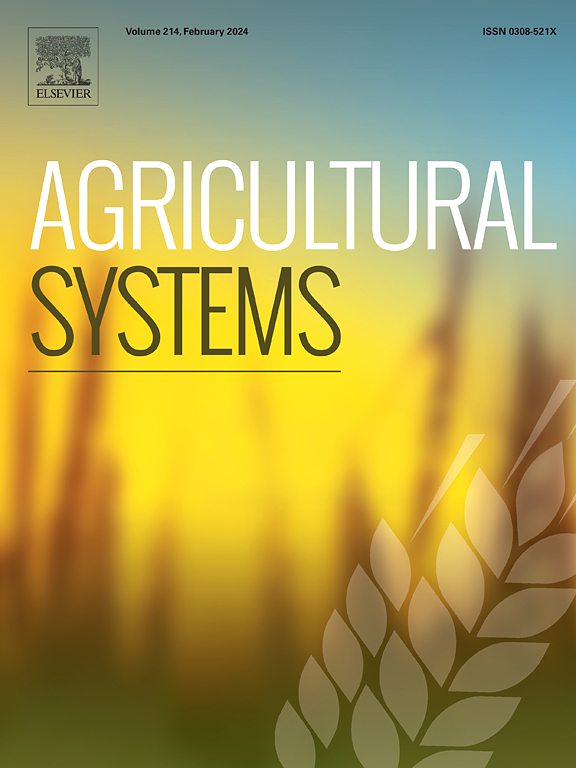Towards automation of national scale cropping pattern mapping by coupling Sentinel-1/2 data: A 10-m map of crop rotation systems for wheat in China
IF 6.1
1区 农林科学
Q1 AGRICULTURE, MULTIDISCIPLINARY
引用次数: 0
Abstract
Context
Wheat, as the world's largest cereal crop, contributes significantly to agricultural intensification through crop rotation systems. Updated knowledge of cropping patterns (CP) describing crop rotations is crucial for the development of sustainable agricultural systems. However, there is a gap in data availability and finer resolution CP maps are not available for most countries, which hampers our knowledge of geographically targeted crop rotation for sustainable management. It is challenging to automatically map CP at large scales due to the lack of ground-truth datasets, the complexity of crop rotation systems, and the limited applicability of existing algorithms.
Objective
This paper has three objectives: 1) propose approaches for automatic mapping of wheat cropping patterns; 2) assess its capability through its applications over conterminous China; 3) explore the distribution patterns for wheat of crop rotation systems in China.
Methods
This study introduced a novel framework for automatic agricultural mapping by proposing CP indices based on coupled patterns of multi-source imagery and inter-seasonal variations. This study developed the first 10-m wheat Cropping Patterns (ChinaCP-Wheat10m) distribution map over conterminous China by proposing a robust algorithm for mapping Wheat cropping Patterns by fusing Sentinel-1 SAR and Sentinel-2 MSI data (WPSS).
Results and conclusion
The ChinaCP-Wheat10m map showed that wheat dominated the north of the Yangtze River and east of the Taihang Mountain, with a distinctive spatial pattern of winter wheat-rice or upland crops divided by the Huaihe River. There was 206,919 km2 of wheat sown area in China in 2020, and over 90 % of national wheat cultivation was implemented by double cropping. More than half of national wheat farming was intensified through rotation by maize (51.39 %), followed by paddy rice (21.12 %) and other upland crops (18.90 %). There was a small proportion of single cropping by spring wheat (6.86 %) and winter wheat (1.73 %). The reliability of the WPSS was validated by 17,627 widely distributed reference sites with an overall accuracy of 92.57 % and good agreement with the agricultural census data (R2 = 0.96).
Significance
This study opens a new direction to move from crop type identification to the automatic generation of crop rotation maps at the national scale, which would facilitate the progress of the Sustainable Development Goals (SDGs) to reduce poverty and hunger. The processing codes and wheat CP records produced in China can be downloaded from the following link: https://doi.org/10.6084/m9.figshare.28668173.v1

基于Sentinel-1/2数据耦合的全国范围种植格局制图自动化研究——中国小麦轮作系统10米地图
小麦作为世界上最大的谷类作物,通过轮作制度对农业集约化作出了重大贡献。关于描述作物轮作的种植模式(CP)的最新知识对可持续农业系统的发展至关重要。然而,在数据可用性方面存在差距,大多数国家没有更精细的CP地图,这阻碍了我们对可持续管理的地理目标作物轮作的了解。由于缺乏真实数据集、作物轮作系统的复杂性以及现有算法的有限适用性,在大尺度上自动绘制CP是一项挑战。目的:提出小麦种植模式自动制图方法;2)通过在中国周边地区的应用评估其能力;3)探索轮作制度下中国小麦的分布格局。方法提出了基于多源影像耦合模式和季节间变化的CP指数,为农业自动制图提供了新的框架。本研究通过融合Sentinel-1 SAR和Sentinel-2 MSI数据(WPSS),提出了一种强大的小麦种植模式绘制算法,绘制了首张中国连续10米小麦种植模式分布图(chinacp - wheat10米)。结果与结论ChinaCP-Wheat10m地图显示,长江以北和太行山以东以小麦为主,以淮河为界,呈现出明显的冬小麦-水稻或旱地作物的空间格局。2020年,全国小麦播种面积206919平方公里,全国小麦复种率达90%以上。全国一半以上的小麦种植是通过玉米轮作来强化的(51.39%),其次是水稻(21.12%)和其他旱地作物(18.90%)。春小麦单作占6.86%,冬小麦单作占1.73%。17627个分布广泛的参考点验证了WPSS的可靠性,总体精度为92.57%,与农业普查数据吻合较好(R2 = 0.96)。意义本研究开辟了从作物类型识别到全国范围内作物轮作图自动生成的新方向,将促进可持续发展目标(SDGs)减少贫困和饥饿的进程。中国生产的加工代码和小麦CP记录可从以下链接下载:https://doi.org/10.6084/m9.figshare.28668173.v1
本文章由计算机程序翻译,如有差异,请以英文原文为准。
求助全文
约1分钟内获得全文
求助全文
来源期刊

Agricultural Systems
农林科学-农业综合
CiteScore
13.30
自引率
7.60%
发文量
174
审稿时长
30 days
期刊介绍:
Agricultural Systems is an international journal that deals with interactions - among the components of agricultural systems, among hierarchical levels of agricultural systems, between agricultural and other land use systems, and between agricultural systems and their natural, social and economic environments.
The scope includes the development and application of systems analysis methodologies in the following areas:
Systems approaches in the sustainable intensification of agriculture; pathways for sustainable intensification; crop-livestock integration; farm-level resource allocation; quantification of benefits and trade-offs at farm to landscape levels; integrative, participatory and dynamic modelling approaches for qualitative and quantitative assessments of agricultural systems and decision making;
The interactions between agricultural and non-agricultural landscapes; the multiple services of agricultural systems; food security and the environment;
Global change and adaptation science; transformational adaptations as driven by changes in climate, policy, values and attitudes influencing the design of farming systems;
Development and application of farming systems design tools and methods for impact, scenario and case study analysis; managing the complexities of dynamic agricultural systems; innovation systems and multi stakeholder arrangements that support or promote change and (or) inform policy decisions.
 求助内容:
求助内容: 应助结果提醒方式:
应助结果提醒方式:


